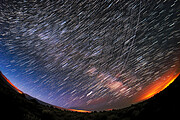Media Advisory: IAU Centre for the Protection of the Dark and Quiet Sky from Satellite Constellation Interference
1 February 2022
On 3 February 2022 leaders of the International Astronomical Union (IAU), NSF NOIRLab, and the SKA Observatory (SKAO) will hold a virtual press conference to announce the newly established IAU Centre for the Protection of the Dark and Quiet Sky from Satellite Constellation Interference. The press conference, to be conducted via Zoom, will begin on 3 February 2022 at 11:00 a.m. MST (18:00 UT) and last at most one hour. Registration is free to accredited media representatives; instructions appear below.
The organizations hosting the center and the directors have been decided. This press conference will announce these details.
Briefing Participants
- Debra Elmegreen, IAU
- Connie Walker, NSF NOIRLab/IAU
- Piero Benvenuti, University of Padova/IAU
- Federico Di Vruno, SKAO
- Meredith Rawls, University of Washington/Vera C. Rubin Observatory
- Richard Green, University of Arizona
- Jessica Heim, University of Southern Queensland
Registration
Bona-fide journalists can register for the press briefing here. Upon approval by the NOIRLab and SKAO Media Relations Offices, you will receive an email with instructions on how to connect via Zoom. The deadline to register is 3 February at 8 a.m. MST (15:00 UT).
Space at the press briefing is limited. If we are not able to accommodate you on Zoom, you may watch the briefing live-streamed on the NOIRLab YouTube channel or the IAU YouTube channel, but you will not be able to ask questions.
More information
NSF NOIRLab(National Optical-Infrared Astronomy Research Laboratory), the US center for ground-based optical-infrared astronomy, operates the International Gemini Observatory(a facility of NSF, NRC–Canada, ANID–Chile, MCTIC–Brazil, MINCyT–Argentina, and KASI–Republic of Korea), Kitt Peak National Observatory (KPNO), Cerro Tololo Inter-American Observatory (CTIO), the Community Science and Data Center (CSDC), and Vera C. Rubin Observatory(operated in cooperation with the Department of Energy’s SLACNational Accelerator Laboratory). It is managed by the Association of Universities for Research in Astronomy (AURA) under a cooperative agreement with NSF and is headquartered in Tucson, Arizona. The astronomical community is honored to have the opportunity to conduct astronomical research on Iolkam Du’ag (Kitt Peak) in Arizona, on Maunakea in Hawai‘i, and on Cerro Tololo and Cerro Pachón in Chile. We recognize and acknowledge the very significant cultural role and reverence that these sites have to the Tohono O'odham Nation, to the Native Hawaiian community, and to the local communities in Chile, respectively.
The SKAO, formally known as the SKA Observatory, is an inter-governmental organisation composed of Member States from five continents. Its mission is to build and operate cutting-edge radio telescopes to transform our understanding of the Universe, and deliver benefits to society through global collaboration and innovation. Headquartered in the UK, its two telescope arrays will be constructed in Australia and South Africa and be the two most advanced radio telescope networks on Earth. A later expansion is envisioned in both countries and other African partner countries. Together with other state-of-the-art research facilities, the SKAO’s telescopes will explore the unknown frontiers of science and deepen our understanding of key processes, including the formation and evolution of galaxies, fundamental physics in extreme environments and the origins of life. Through the development of innovative technologies and its contribution to addressing societal challenges, the SKAO will play its part to address the United Nations’ Sustainable Development Goals and deliver significant benefits across its membership and beyond. The SKAO recognises and acknowledges the Indigenous peoples and cultures that have traditionally lived on the lands on which the SKAO facilities are located.
The IAU is the international astronomical organisation that brings together more than 12 000 active professional astronomers from more than 100 countries worldwide. Its mission is to promote and safeguard astronomy in all its aspects, including research, communication, education and development, through international cooperation. The IAU also serves as the internationally recognised authority for assigning designations to celestial bodies and the surface features on them. Founded in 1919, the IAU is the world's largest professional body for astronomers.
Links
Contacts
Amanda Kocz
NSF NOIRLab Communications
Email: amanda.kocz@noirlab.edu
Lars Lindberg Christensen
NSF NOIRLab Head of Communications, Education & Engagement/IAU Director of Communications
Cell: +1 520 461 0433
Email: lars.christensen@noirlab.edu
William Garnier
Director of Communications, Outreach and Education
SKA Observatory
Email: William.Garnier@skao.int






